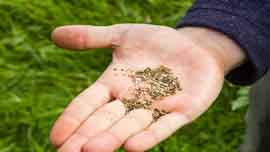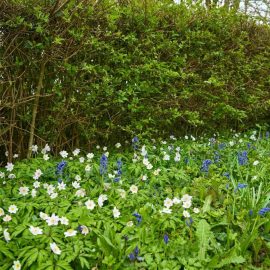Wildflower Seeds for Woodland and Heavy Shade: Locally Sourced Solutions for Flourishing Understory Meadows
Woodland and heavily shaded areas often go overlooked in landscaping projects, but they hold incredible potential for beauty and biodiversity. You can transform these spaces into thriving understory meadows with the right wildflower seeds for woodland shade. Locally sourced wildflower seeds, like those from Wildahome, are ideal for ensuring success in shaded environments while supporting local ecosystems. Let’s explore why wildflowers flourish in heavy shade and how to create a stunning woodland wildflower garden.
Understanding Woodland and Heavy Shade Areas
Woodland areas are defined by dense tree canopies that filter sunlight, creating partial to deep shade conditions. While these environments pose challenges for many plants, they are perfect for shade-adapted wildflowers.
The Unique Challenges of Growing Plants in Woodland Shade
Growing in woodland shade requires plants to compete with large tree roots for nutrients and moisture. Additionally, the thick leaf litter on the forest floor can smother seedlings, making it difficult for them to establish.
How Low Light Affects Plant Growth in Dense Woodlands
Woodland floors receive limited direct sunlight, slowing photosynthesis. However, many wildflowers bloom early in spring before the canopy fills in, using the brief window of light.
Benefits of Planting Wildflowers in Shaded Areas
Wildflowers in woodland areas support local ecosystems, provide shelter for wildlife, and prevent soil erosion. Their vibrant blooms and foliage also transform shaded spaces into stunning natural landscapes.
Why Wildflowers Thrive in Woodland and Heavy Shade
Despite the challenges, many wildflowers naturally adapt to low-light environments, making them ideal for woodland habitats.
Adaptations of Wildflowers to Low-Light Environments
Woodland wildflowers, such as spring ephemerals, bloom early to take advantage of sunlight before tree leaves block it. Their deep roots help them access nutrients below the tree line, and they often reproduce through rhizomes, allowing them to spread even under leaf litter.
Supporting Biodiversity in Shaded Woodland Areas
Native wildflowers provide nectar and pollen for pollinators like bees, butterflies, and hummingbirds. They also create shelter for small mammals, amphibians, and beneficial insects, fostering a healthy ecosystem.
The Role of Wildflowers in Enhancing the Forest Floor
Wildflowers stabilise the soil with deep roots, reducing erosion and promoting healthy soil ecosystems. Over time, they also contribute organic matter to the forest floor, enriching the soil for future plant growth.
Choosing the Right Wildflower Seeds for Woodland and Heavy Shade
Best Wildflower Varieties for Dense Shade
Here are some of the top native British wildflowers suited to woodland and shaded areas:
Wood Anemone (Anemone nemorosa): A classic spring ephemeral with delicate white flowers.
Wild Garlic (Allium ursinum): Fragrant white blooms that carpet the forest floor in spring.
Red Campion (Silene dioica): Bright pink flowers that thrive in dappled shade.
Bluebell (Hyacinthoides non-scripta): Iconic blue blooms, essential for British woodland habitats.
Foxglove (Digitalis purpurea): Tall spikes of purple flowers that attract bees.
Importance of Native Wildflowers for Woodland Habitats
Native species are well-adapted to local soil, light, and climate conditions, requiring less maintenance and supporting local wildlife more effectively than non-native species.
How to Select the Right Seed Mix for Woodland Conditions
Choose a seed mix explicitly designed for shaded areas. Wildahome offers specially curated mixes containing native British wildflowers suited to dappled and deep-shade environments.
Wildahome: Locally Sourced Wildflower Seeds for Woodland Success
Locally sourced seeds are crucial when planting wildflowers in shaded areas. Wildahome provides expertly curated wildflower seed mixes designed for woodland habitats.
Why Locally Sourced Seeds Are Ideal for Woodland Areas
Locally sourced seeds are adapted to the regional climate and soil conditions, resulting in higher germination rates and more vigorous plants. They are also genetically suited to support local pollinators and wildlife.
Supporting Local Ecosystems with Native Seed Varieties
By planting native wildflowers from Wildahome, you contribute to preserving local biodiversity. Native plants provide the habitat and food that local species need to survive.
How Wildahome Seeds Ensure Thriving Growth in Shaded Areas
Wildahome’s seed mixes are tailored explicitly for dense shade and woodland conditions. They include a carefully selected blend of spring ephemerals, hardy perennials, and shade-loving species to ensure continuous blooms and healthy growth.
Preparing and Planting Wildflower Seeds in Woodland and Heavy Shade
Proper site preparation is key to the success of your woodland wildflower garden.
Evaluating Soil and Light Levels in Heavy Shade
Test your soil’s pH and texture. Most woodland wildflowers prefer slightly acidic to neutral soil with good organic content. Identify areas with dappled sunlight for species that need partial shade and deep shade areas for shade-loving varieties.
Clearing the Woodland Floor for Wildflower Growth
Remove invasive plants and excessive leaf litter, but leave some natural debris to maintain the forest ecosystem. Be careful not to disturb tree roots.
Enhancing Soil Health in Shaded Environments
Improve the soil with compost or leaf mould to increase organic matter. Avoid chemical fertilisers, which can disrupt the natural ecosystem.
Step-by-Step Guide to Sowing Wildflower Seeds in Woodland Areas
1. Timing: Plant seeds in fall or early spring. Fall planting allows seeds to undergo natural stratification, improving germination rates.
2. Sowing: Scatter seeds directly onto the soil surface. Do not bury them deeply; many woodland wildflowers require light to germinate.
3. Soil Contact: Lightly rake the soil or press the seeds onto the surface using a board.
4. Watering: Keep the area moist until the seeds germinate. Use a gentle spray to prevent disturbing the seeds.
5. Mulching: Add a thin layer of leaf mulch to retain moisture without blocking sunlight.


Caring for Wildflowers in Woodland and Heavy Shade Areas
Once established, woodland wildflowers are low-maintenance. However, some care ensures a thriving ecosystem.
Maintaining Moisture Levels in Shaded Areas
Shaded areas typically retain moisture, but water deeply and less frequently during dry spells to encourage profound root growth.
Encouraging Natural Regeneration of Woodland Wildflowers
Allow some flowers to go to seed, enabling natural reseeding and creating a self-sustaining wildflower meadow over time.
Managing Competition from Invasive Species in Dense Shade
Regularly monitor and remove invasive species like rhododendrons or Japanese knotweed, which can outcompete native wildflowers.
The Environmental and Aesthetic Benefits of Woodland Wildflowers
Wildflowers do more than beautify woodland areas—they contribute significantly to local ecosystems.
Supporting Pollinators and Wildlife in Woodland Habitats
Wildflowers provide critical nectar and pollen sources for bees, butterflies, and hummingbirds. Their seeds and foliage also support birds and small mammals.
Transforming Shaded Areas Into Vibrant Landscapes
A well-planned wildflower meadow brings colour, texture, and fragrance to shaded woodlands, turning overlooked spaces into enchanting natural havens.
Enhancing Soil Health and Preventing Erosion in Forested Areas
The deep roots of wildflowers stabilise soil, reducing erosion and improving soil health over time.
Wildahome wildflower mixes for shaded areas are carefully curated to ensure success in woodland environments.
Commitment to Sustainability and Locally Sourced Seeds
Wildahome partners with local growers to source native seeds, reducing transportation impacts and preserving local biodiversity.
Wildahome’s Expertise in Tailored Seed Mixes for Woodland Shade
With years of experience, Wildahome designs seed mixes that thrive in the specific conditions of woodland and heavy shade areas.
Real-Life Success Stories: Transforming Woodlands with Wildahome Seeds
From private woodland gardens to public nature reserves, Wildahome customers have created stunning wildflower displays, supporting local ecosystems and enhancing shaded landscapes.
FAQs About Wildflower Seeds for Woodland and Heavy Shade
Q: Can wildflowers grow in complete shade?
A: Many native species like Wood Anemone and Wild Garlic thrive in deep shade, while species like Foxglove prefer dappled light.
Q: Why should I choose locally sourced seeds?
A: Locally sourced seeds from Wildahome are better adapted to British climates, supporting local pollinators and providing better long-term growth.
Q: How long does it take for woodland wildflowers to establish?
A: Some species bloom in the first year, but most native perennials take 2–3 years to form a fully established meadow.
Q: Can I plant woodland wildflowers under existing trees?
A: Yes, many woodland species, such as Bluebells and Wood Anemone, are adapted to grow under tree canopies. Just be careful not to damage tree roots when preparing the soil.
Q: When is the best time to plant woodland wildflower seeds?
A: Autumn is ideal, as many native seeds benefit from winter stratification, which helps improve germination rates in spring.
Q: Do I need to fertilise woodland wildflowers?
A: No, most native woodland species thrive in low-nutrient soils. Adding compost or leaf mould for organic matter is sufficient.
By using Wildahome wildflower mixes for shaded areas, you can create a flourishing woodland wildflower garden that is both beautiful and beneficial to the environment. With native, locally sourced wildflower seeds tailored for dense shade, your woodland will transform into a vibrant, biodiverse habitat for years.

